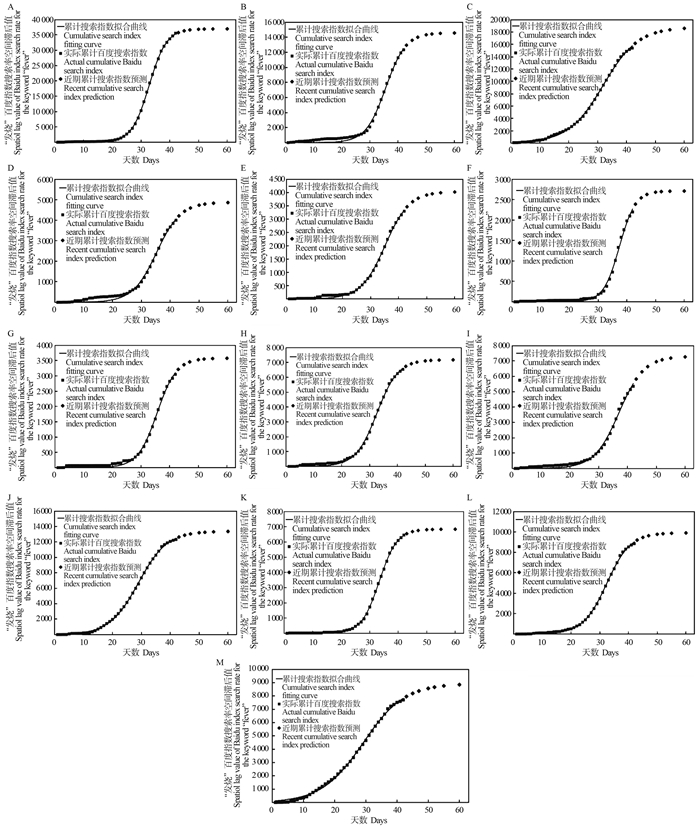Peak prediction and spatial distribution characteristics of COVID-19 in Beijing-Tianjin-Hebei region based on baidu index
-
摘要:
目的 分析2022年11月11日―12月22日京津冀地区各市COVID-19的进展周期和空间聚集情况。 方法 基于各市每日“发烧”关键词百度指数搜索数据,使用logistic回归分析模型模拟并预测此轮COVID-19发展进程,对感染进展周期划分为渐增期、快增期及缓增期,预测感染高峰日,同时对“发烧”百度指数搜索率进行全局和局部空间自相关分析。 结果 从logistic回归分析模型模拟及预测结果来看,模型拟合效果较好,各市COVID-19流行进展速度及流行阶段各不相同,石家庄市、保定市及邢台市最早进入感染快增期阶段;空间自相关分析显示仅有5 d京津冀地区存在全局空间正相关性(Moran′s I: 0.314~0.491, 均P < 0.05),其他时间均呈随机分布。 结论 京津冀地区此轮COVID-19流行均呈暴发趋势,各市疫情进展阶段及感染高峰有较大差异,且大部分时间不存在显著的空间自相关,为卫生医疗配置提供参考依据。 Abstract:Objective To analyze the progression cycle and spatial clustering of the coronavirus disease 2019(COVID-19)in Beijing-Tianjin-Hebei region from November 11 to December 22, 2022. Methods Based on the daily fever keyword Baidu index search data in each city, the logistic model was used to simulate and predict the development process of this round of COVID-19 infection. The infection progression cycle was divided into an increasing period, a rapid increase period and a slow increase period, and the peak day of infection growth was predicted. At the same time, the global and local spatial autocorrelation analysis of the fever Baidu index search rate was conducted. Results The logistic model simulation and prediction yielded a robust model fitting effect. The epidemic progression speed and stage of COVID-19 infection varied across cities. Shijiazhuang City, Baoding City and Xingtai City were the first to enter the rapid increase stage of infection. Spatial autocorrelation analysis showed that there was a significant global spatial positive correlation in Beijing-Tianjin-Hebei region only for 5 days (Moran′s I: 0.314~0.491, P value was < 0.05), whereas other times exhibited random distribution. Conclusions This round of COVID-19 infection epidemic in Beijing-Tianjin-Hebei region shows an outbreak trend. The epidemic progress stage and infection peak in each city are significantly different, and most of the time there is no significant spatial autocorrelation, which provides a reference for health care configuration. -
Key words:
- COVID-19 /
- Baidu index /
- Temporal-spatial analyze
-
图 1 京津冀各市COVID-19进展的logistic回归分析模型拟合及预测
1. A: 北京市; 2. B: 天津市; 3. C: 石家庄市; 4. D: 衡水市; 5. E: 张家口市; 6. F: 承德市; 7. G: 秦皇岛市; 8. H: 廊坊市; 9. I: 沧州市; 10. J: 保定市; 11. K: 唐山市; 12. L: 邯郸市; 13. M: 邢台市。
Figure 1. Logistic regression analysis model fitting and prediction of COVID-19 progress in various cities of Beijing-Tianjin-Hebei
1. A: Beijing City; 2. B: Tianjin City; 3. C: Shijiazhuang City; 4. D: Hengshui City; 5. E: Zhangjiakou City; 6. F: Chengde City; 7. G: Qinhuangdao City 8. H: Langfang City; 9. I: Cangzhou City; 10. J: Baoding City; 11. K: Tangshan City; 12. L: Handan City; 13. M: Xingtai City.
图 2 京津冀“发烧”百度指数搜索率空间自相关局部Moran散点图
1. A:2022年11月18日;2. B:2022年11月22日;3. C:2022年11月24日;4. D:2022年12月6日;5. E:2022年12月7日。
Figure 2. Spatial autocorrelation local Moran scatter plot of Baidu index search rate for "fever" in Beijing-Tianjin-Hebei region
1. A: November 18, 2022; 2. B: November 22, 2022; 3. C: November 24, 2022; 4. D: December 6, 2022; 5. E: December 7, 2022.
表 1 京津冀各市COVID-19进展阶段及感染增长高峰日预测结果
Table 1. Forecast results of COVID-19 infection progression stage and infection growth peak day in Beijing-Tianjin-Hebei region
地区 Area k值
valueN值
valuec值
value渐增期结束日期(月/日)
Incremental period end date (Month/Day)快增期(月/日)
Rapid growth period (Month/Day)缓增期开始日期(月/日)
Start date of slow growth period (Month/day)增长高峰日(月/日)
Growth peak day (Month/Day)R2值
valueRMSE值
value北京市 Beijing City 0.331 36 947 -10.866 12/9 12/10―12/17 12/18 12/13 0.999 157.154 天津市 Tianjin City 0.281 14 577 -10.100 12/11 12/12―12/20 12/21 12/16 0.994 281.470 石家庄市 Shijiazhuang City 0.165 18 755 -5.284 12/4 12/5―12/20 12/21 12/12 0.999 140.348 衡水市 Hengshui City 0.240 4 870 -8.470 12/10 12/11―12/21 12/22 12/16 0.991 112.352 张家口市 Zhangjiakou City 0.232 4 028 -8.175 12/10 12/11―12/21 12/22 12/16 0.997 48.295 承德市 Chengde City 0.360 2 708 -13.477 12/14 12/15―12/21 12/22 12/18 0.996 39.209 秦皇岛市 Qinhuangdao City 0.295 3 576 -10.494 12/11 12/12―12/20 12/21 12/16 0.996 57.624 廊坊市 Langfang City 0.262 7 179 -8.563 12/8 12/9―12/18 12/19 12/13 0.998 90.128 沧州市 Cangzhou City 0.250 6 824 -9.102 12/11 12/12―12/22 12/23 12/17 0.994 122.054 保定市 Baoding City 0.220 12 915 -6.273 12/3 12/4―12/15 12/16 12/9 0.998 141.046 唐山市 Tangshan City 0.322 6 837 -10.733 12/9 12/10―12/17 12/18 12/14 0.999 37.088 邯郸市 Handan City 0.242 9 908 -7.851 12/7 12/8―12/18 12/19 12/13 0.999 74.091 邢台市 Xingtai City 0.151 8 923 -4.396 11/30 12/1―12/18 12/19 12/10 0.998 105.894 注:RMSE, 均方误差。
Note: RMSE, root mean square error.表 2 京津冀地区“发烧”关键词百度指数搜索率显著全局空间自相关结果
Table 2. Significant global spatial autocorrelation results of Baidu index search rate for the keyword "fever" in the Beijing-Tianjin-Hebei region
时间(月/日)
Time (Month/Day)Moran′s I值
valueZ值
valueP值
value11/18 0.385 2.876 0.004 11/22 0.491 3.530 0 11/24 0.356 2.372 0.017 12/6 0.339 2.246 0.024 12/7 0.314 2.085 0.037 表 3 京津冀地区“发烧”关键词百度指数搜索率局部空间自相关结果
Table 3. Beijing-Tianjin-Hebei region "fever" keyword Baidu index search rate local space autocorrelation results
时间(月/日)
Time (Month/Day)地区 Area Moran′s I值
valueZ值
valueP值
value11/18 石家庄市 Shijiazhuang City 1.312 3.040 0.002 邢台市 Xingtai City 1.629 3.732 0 11/22 石家庄市 Shijiazhuang City 1.155 2.700 0.007 衡水市 Hengshui City 0.891 2.531 0.011 邢台市 Xingtai City 2.114 4.791 0 11/24 石家庄市 Shijiazhuang City 2.070 4.335 0 邢台市 Xingtai City 1.239 2.662 0.008 12/6 石家庄市 Shijiazhuang City 1.283 2.723 0.006 承德市 Chengde City 0.610 1.989 0.047 12/7 石家庄市 Shijiazhuang City 1.054 2.246 0.025 承德市 Chengde City 0.621 2.012 0.044 注:此表仅列出局部空间自相关结果中显著(P<0.05)城市的莫兰指数值。
Note: This table only lists the Moran′s I values of cities with significant (P < 0.05) local spatial autocorrelation results. -
[1] 詹绍文, 周洋. 突发公共卫生事件下社会救助资源统筹与优化[J]. 北京航空航天大学学报(社会科学版), 2021, 34(5): 51-57. DOI: 10.13766/j.bhsk.1008-2204.2020.0518.Zhan SW, Zhou Y. Coordination and optimization of social assistance[J]. Journal of Beijing University Aeronautics and Astronautics Social Sciences Edition, 2021, 34(5): 51-57. DOI: 10.13766/j.bhsk.1008-2204.2020.0518. [2] 董晓春, 李琳, 徐文体, 等. 特定关键词及百度指数与流感病毒活动相关性分析[J]. 中国公共卫生, 2016, 32(11): 1543-1546. DOI: 10.11847/zgggws2016-32-11-25.Dong XC, Li L, Xu WT, et al. Correlation between Baidu index of specific keywords and influenaz epidemics[J]. Chin J Publ Heal, 2016, 32(11): 1543-1546. DOI: 10.11847/zgggws2016-32-11-25. [3] Ginsberg J, Mohebbi MH, Patel RS, et al. Detecting influenza epidemics using search engine query data[J]. Nature, 2009, 457(7232): 1012-1014. DOI: 10.1038/nature07634. [4] 黄泽颖. 基于百度指数的传染病预测精准性探索——以广东省H7N9亚型禽流感为例[J]. 中国人兽共患病学报, 2020, 36(11): 962-968. DOI: 10.3969/j.issn.1002-2694.2020.00.149.Huang ZY. Exploration of the accuracy of epidemic prediction based on the Baidu index—taking H7N9 subtype avian influenza in Guangdong Province as an example[J]. Chinese Journal of Zoonoses, 2020, 36(11): 962-968. DOI: 10.3969/j.issn.1002-2694.2020.00.149. [5] 钟若曦, 张萌, 谭小华, 等. 基于百度指数的2017—2018年度冬春季广东省流行性感冒疫情舆情走势分析[J]. 中国预防医学杂志, 2019, 20(9): 867-870. DOI: 10.16506/j.1009-6639.2019.09.022.Zhong RX, Zhang M, Tan XH, et al. Trend analysis of influenza outbreak and public concerns based on Baidu index during winter and spring in Guangdong, 2017-2018[J]. Chin J Prev Med, 2019, 20(9): 867-870. DOI: 10.16506/j.1009-6639.2019.09.022. [6] 韦秋宇, 刘洁, 张君涵, 等. 基于百度指数的新型冠状病毒肺炎疫情与网络舆情监测分析[J]. 中国预防医学杂志, 2021, 22(1): 4-9. DOI: 10.16506/j.1009-6639.2021.01.002.Wei QY, Liu J, Zhang JH, et al. Baidu index-based analysis on the association between COVID-19 pandemic and online public attention[J]. Chin J Prev Med, 2021, 22(1): 4-9. DOI: 10.16506/j.1009-6639.2021.01.002. [7] 冯苗胜, 王连生, 林文水. logistic与SEIR结合模型预测新型冠状病毒肺炎传播规律[J]. 厦门大学学报(自然科学版), 2020, 59(6): 1041-1046. DOI: 10.6043/j.issn.0438-0479.202003042.Feng MS, Wang LS, Lin WS. Prediction of COVID-19 transmission law by combining logistic and SEIR model[J]. J Xiamen Univ Nat Sci, 2020, 59(6): 1041-1046. DOI: 10.6043/j.issn.0438-0479.202003042. [8] 徐方, 陆殷昊, 黄晓燕. logistic模型在新型冠状病毒肺炎疫情中的应用[J]. 实用预防医学, 2022, 29(6): 762-766. DOI: 10.3969/j.issn.1006-3110.2022.06.029.Xu F, Lu YH, Huang XY. Application of logistic model to the COVID-19 epidemic[J]. Practical Preventive Medicine, 2022, 29(6): 762-766. DOI: 10.3969/j.issn.1006-3110.2022.06.029. [9] 刘如春, 陈田木, 胡国清. 长沙市某校甲型H1N1流感暴发过程及其防控策略效果的Logistic模型模拟[J]. 中华疾病控制杂志, 2014, 18(4): 330-335. http://zhjbkz.ahmu.edu.cn/article/id/JBKZ201404015Liu RC, Chen TM, Hu GQ. Simulation of influenza a(H1N1) outbreak and the effect of interventions with Logistic model in a school in Changsha City[J]. Chin J Dis Control Prev, 2014, 18(4): 330-335. http://zhjbkz.ahmu.edu.cn/article/id/JBKZ201404015 [10] 黄澳迪, 唐林, 王晓琪, 等. 中国2011—2021年戊型病毒性肝炎发病趋势和时空聚集性[J]. 中国疫苗和免疫, 2022, 28(4): 417-421. DOI: 10.19914/j.CJVI.2022080.Huang AD, Tang L, Wang XQ, et al. Hepatitis E incidence trends and spatial-temporal clustering in China, 2011-2021[J]. Chinese Journal of Vaccines and Immuniation, 2022, 28(4): 417-421. DOI: 10.19914/j.CJVI.2022080. [11] 何佳晋, 袁璐, 吴超. 2010—2019年中国艾滋病流行时空分布特征[J]. 中华疾病控制杂志, 2022, 26(5): 541-546. DOI: 10.16462/j.cnki.zhjbkz.2022.05.009.He JJ, Yuan L, Wu C. Temporal-spatial distribution of AIDS epidemic in China, 2010-2019[J]. Chin J Dis Control Prev, 2022, 26(5): 541-546. DOI: 10.16462/j.cnki.zhjbkz.2022.05.009. [12] 段在鹏, 艾仁华. COVID-19疫情在我国的空间特征及影响因素分析[J]. 安全与环境学报, 2022, 22(2): 892-900. DOI: 10.13637/j.issn.1009-6094.2020.1524.Duan ZP, Ai RH. Analysis of the spatial characteristics and influencing factors of COVID-19 epidemic in China[J]. J Saf Environ, 2022, 22(2): 892-900. DOI: 10.13637/j.issn.1009-6094.2020.1524. [13] 李建军, 何山. 人口流动、信息传播效率与疫情防控——基于新型冠状肺炎(COVID-19)的证据[J]. 中央财经大学学报, 2020, (4): 116-128. DOI: 10.19681/j.cnki.jcufe.2020.04.010.Li JJ, He S. Population movement, information dissemination efficiency and disease control: evidence from coronavirus disease 2019[J]. J Central Univ Finance Econ, 2020, (4): 116-128. DOI: 10.19681/j.cnki.jcufe.2020.04.010. [14] 方辉, 王玉光, 张宁, 等. 新型冠状病毒奥密克戎感染轻症患者中医证候学调查研究[J]. 北京中医药, 2023, 42(1): 19-23. DOI: 10.16025/j.1674-1307.2023.01.005.Fang H, Wang YG, Zhang N, et al. Investigation on TCM syndromes of mild patients infected with novel coronavirus Omikron[J]. Beijing J Trad Chin Med, 2023, 42(1): 19-23. DOI: 10.16025/j.1674-1307.2023.01.005. [15] 黎倩, 洪峰, 王丹, 等. 基于百度指数的ARDL模型在贵州省手足口病发病预测中的应用探讨[J]. 现代预防医学, 2023, 50(3): 416-421. DOI: 10.20043/j.cnki.MPM.202207398.Li Q, Hong F, Wang D, et al. To explore the application of ARDL model based on Baidu index in the prediction of hand-foot-and-mouth disease incidence in Guizhou Province[J]. Modern Preventive Medicine, 2023, 50(3): 416-421. DOI: 10.20043/j.cnki.MPM.202207398. [16] 王玥, 周海涛, 岳婷雨, 等. 基于百度指数的2011—2020年江苏省肺结核预测模型研究[J]. 疾病监测, 2023, 38(1): 95-100. DOI: 10.3784/jbjc.202207120316.Wang Y, Zhou HT, Yue TY, et al. Research of prediction model of pulmonary tuberculosis in Jiangsu during 2011-2020 based on Baidu index[J]. Dis Surveill, 2023, 38(1): 95-100. DOI: 10.3784/jbjc.202207120316. -





 下载:
下载:


